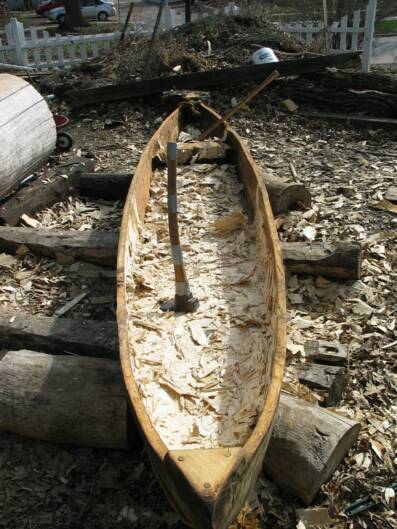I got my first canoe for my 19th Birthday and I've been usin' it for over thirty years now. But, in the back of my mind, as I glided silently through the best of God's creation, I wished I could be the pioneer who first saw what was around this bend in the river. About the only thing that stood between my fantasy and reality, was the 18' aluminum Grumman white-water canoe I was sittin' in, (and 200 years).
So, in the fall of 2008, me and my two youngest sons went and got dimensions off an original dugout canoe, perhaps burned out of a local cottonwood by an Ioway Indian. Armed with photos and measurements, we went scoutin' for a tree.
Makin' a Dugout Canoe
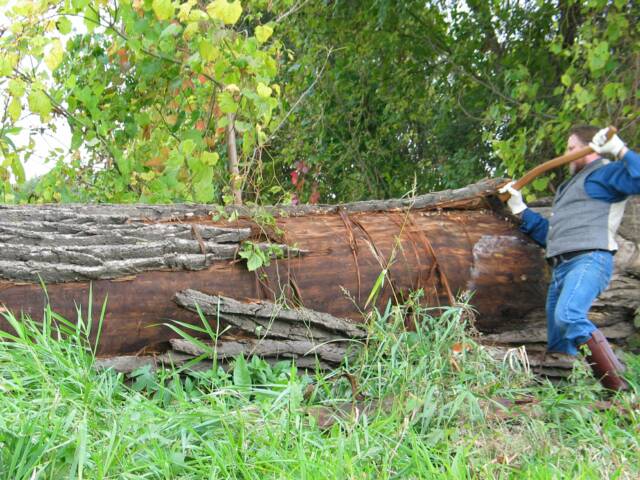
We found a cottonwood that had been standin' dead till it had been washed down in the spring floods. It was long enough I could cut it into two 8' canoes for the little boys, and one 12' canoe for me. But first, I had to bark it to stop the bugs from eatin' it up.
Gus, (7 at the time), hauls loose bark to toss over the log into the brush. Patriot, (then 6), balances on the log pretending to work as hard as Gus and practices his management skills. In the photo above, I loosen and pry bark off with my large foot adze. Worked good.
After cuttin' the log into the right lengths, I began to square-off the top and bottom of one of the 8' sections. But, it became too difficult breaking away from home to work on the logs for any period of time. I realized I was goin' to have to haul 'em up to the house so I could work on 'em a little bit at a time. The problem was, the longest of the logs, twelve and a half feet in length and three feet across at the base, probably weighed over a ton. It took me almost a year to organize the right time and place to get the logs hauled up to the house.
Mark Low, a true friend, fellow veteran, and current Air Guard member, had a 4X4, a trailer and a portable electric winch. In August of '09, just days after getting back from a recent deployment, (during a day when he probably should have been catchin' up on his own personal life), Mark stood next to three large logs lookin' back and forth between the logs and his trailer. With ingenuity and resolve, characteristic of America's Armed Service Men and Women, and over five hours of non-stop, backbreakin', sweat-drenched, hard work, Mark had all three logs in my back yard!
We laughed, talked about how crazy what we just accomplished was, took a couple pictures, and Mark was gone. Even though it was 1:30 in the afternoon and we hadn't had anything resembling a break, Mark turned down my offer to buy him lunch, and just drove off.
I wasn't goin' to be able to do much burnin' on 'em 'cause I was only goin' to be able to work on 'em one or two hours at a time. However, I decided I would retain the same shape the dugouts have from being burned. I would mimic it using my bladed hand tools. The surface will be scorched as part of the finishing step, both to smooth the surface and heat-temper the wood.
After eyeballin' the ends of the log and guessin' where to mark the bottom of the dugout, I cut across the log to the depth I had decided on for the bottom of the dugout. Then, usin' four iron wedges, I began splittin' off the bottom in sections and settin' 'em aside for firewood.
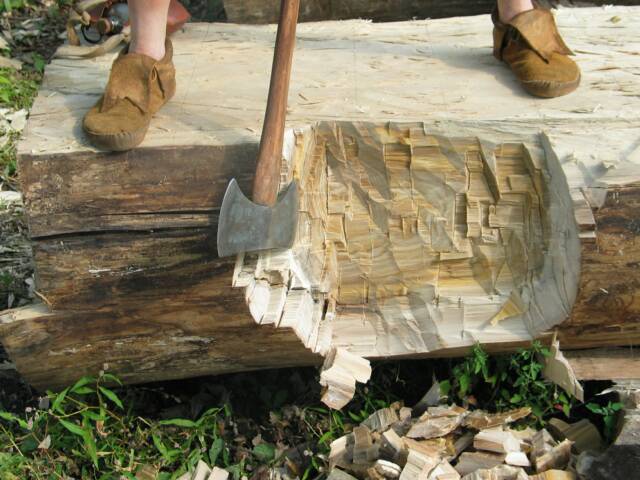
After splittin' off the bottom, I smoothed it out usin' my small and large foot adzes. Then, I drew out the curve of the bow and stern, marked the width of the bottom of the dugout, and chiseled the markings into the wood so they wouldn't wash out with the next rain.
Then, I began to rough-out the ends with my axe. This went along pretty quick, till I got over-exuberant and busted my axe handle! I had just replaced it this spring. Just as well though, I was ignoring a lower back ache that was destined to haunt me for days. If I hadn't stopped then, I would'a crippled myself.
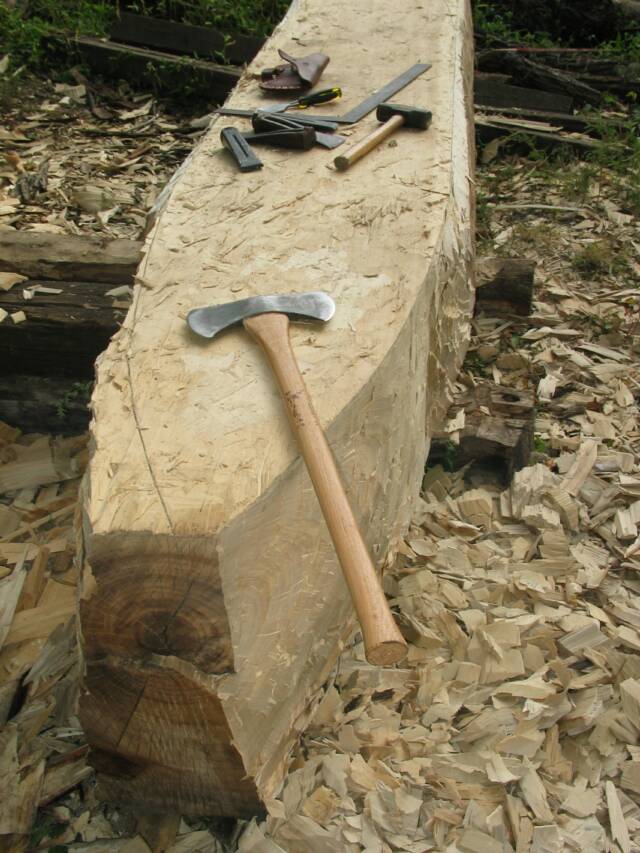
I don't know if this will be the bow or the stern, but it's startin' to take shape. By layin' the carpenter's square across the bottom, I can square off the sides of the bow or stern with a chisel and hammer.
At this point here, I had about 10 or 12 hours in the project. I think it's movin' along pretty good.
Since the first
immigrants settled
along streams and rivers,
(those ancient ones who are
now mistakenly called "Indians"
or "Native American"), the very rivers
they settled along became the lifelines of
their societies. River travel provided those
early inhabitants a freedom of movement not
possible through the dense forests or vast plains.
Early crude vessels, burned out of logs with
fire and scraped with shells from the waters
themselves, transported families and
possessions, game and trade goods,
distances not possible on foot.
Revolutionizing societal
structure, the dugout
was the technological
marvel of its day.
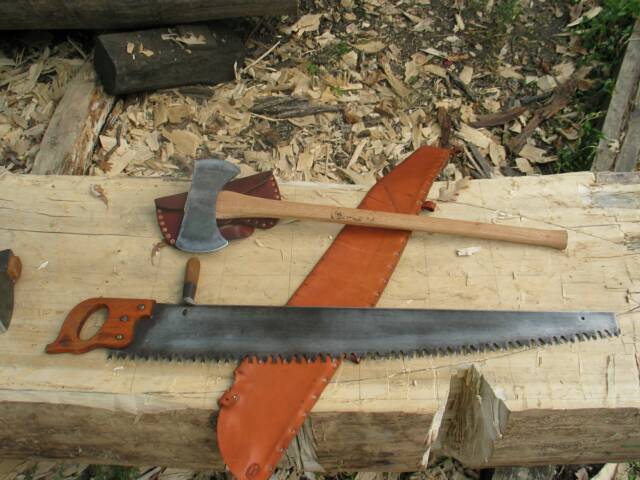
My tools consist largely of old ones I have picked up along life's way. Above you see my one-man/two-man crosscut saw. Works mighty fine. Above that is one of the finest axes I have ever owned. Bites clean and deep with a crisp "clump". When my dad bought it in ol' Kaintuck, he was told it was once used by Dan'l Boone to fell and chop out the 30' dugout Boone made to float his family down the Ohio and on up to his new home in Missouri territory. When my pa remarked it looked to be in mighty fine shape for an axe that old, the feller replied, "Why, I take good care of it. I've replaced the handle seven times since I got it from my pa, and the head only wonst." I myself have replaced the handle twice in the last week.
To the right, at the top, is my right-handed carpenter's hatchet. It is beveled only on the right side of the blade so you can shave off just what you need to make a timber joint fit just right. I need a left-handed one to work with the grain on ta' other side of the dugout. Under that is my small adze, then my foot adze. Those are what I used to plain-off the bottom of the dugout. The bottom tool picture is of my carpenter's square, laid along the bottom of the dugout to get a good even side on the bow and stern of the dugout. My two-pound hand sledge runs my newfangled 2" chisel for doin' the fine work.
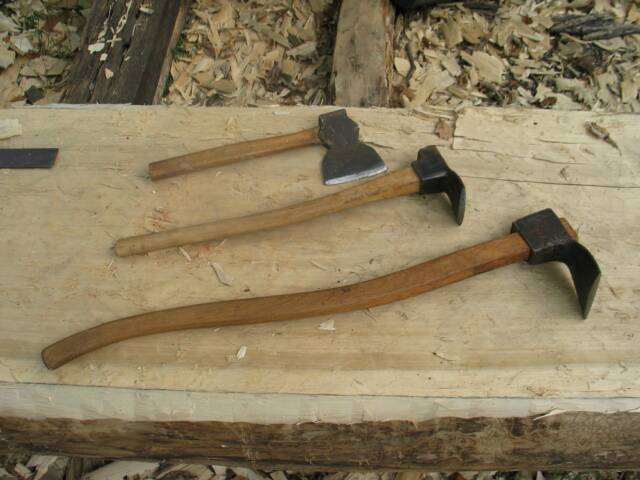
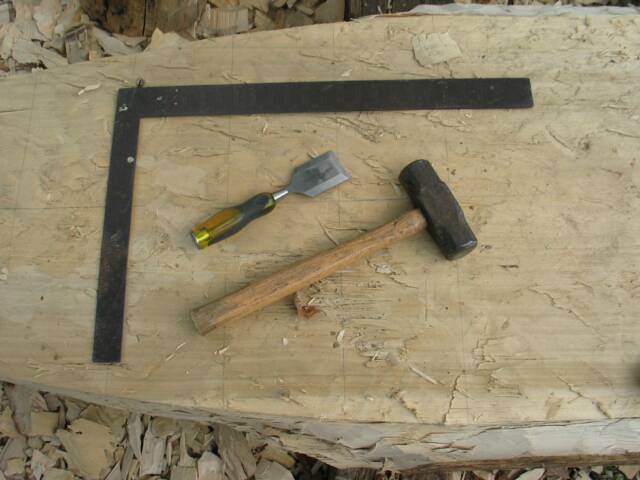
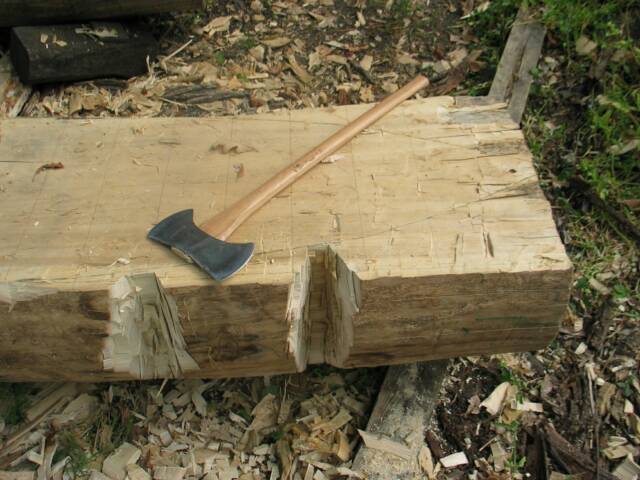
I've gotten a system down for trimmin' wood off of the stern and bow quickly. Cut notches the depth to be trimmed, then knock big chunks out with the wedges. Then, get over exuberant while cleaning it up and bust the head off your axe. It takes about five minutes to cut the nocks in the log, about a minute to split off the excess, and 25 minutes to run to the hardware store for a new handle. I guess that's still quicker than whittlin' a new one out of a limb.
Today is September 11th, 2009. I'm saddened by my memories of that fateful morning eight years ago. I'm heartsick over the state of my nation today. But, the only thing I have control of is my little corner of life. So, I work to create things of value and relieve my troubles with the ache and sweat of hard work.
The sides of both the bow and stern are carved to a point. Next, I'll tack a string from one end to the other and make sure I've got the bottom as straight and level as practical. Then, I'll cut in the arch that'll bring the bow and stern gracefully up out of the water. I've got about 17 hours in it now.
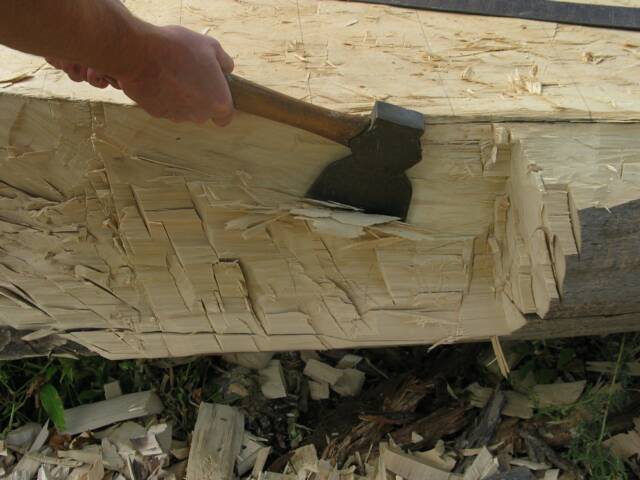
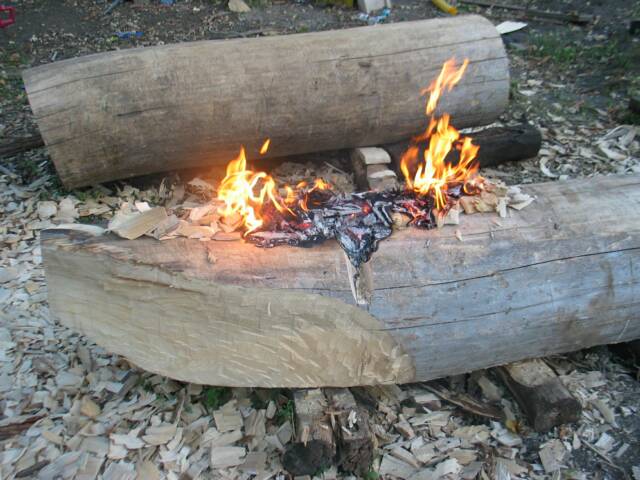
The right-handed carpenter's hatchet works quite well for squaring off the curved sides of the bow and stern.
With the ends brought to a point, it was time to bring them up out of the water. I used the cross-cut to set the depth of the curve.
Using wedges, I slabbed-off sections to quickly rough-out the bow and stern curves. This graceful curve to the ends of dugouts was the result of burning the log into sections prior making the dugout.
Using the axe in a bouncing swing, I was able to smooth out the curves. Working upside-down with iron bladed cutting tools, I can still mimic the effects of the fire burning the log into the dugout-length section.
By the time I had both ends curved up, (upside-down of course), I had about 25 hours in the dugout.
Time to flip the log over and start workin' on the top. I use the term "flip" rather loosely. Using a lever, I could get it this far gruntin'.
The dugout spent quite a while layin' on its side like this. Finally, by hookin' a rope and a couple of pulleys to the two logs next to it, and runnin' the rope under and over the top, I was able to flop it over against the other log. I wetted down the supporting timbers, moved all the logs I had used for block out of the way, and shimmied it down and back into position. That baby is still heavy! Now, I had over 26 hours in the project.
With about a foot and a half thickness of log to get rid of, (at the trunk end), I figured it was time to experiment with burnin'. I chopped a cross section in the log to lay coals in and pile chips on, (got plenty of chips). What I found out is, you don't want a big hot fire. The heat penetrates deeply into the log. It also chases down cracks and burns deeper than you can see, until you scrape the over-burn off. You have to scrape the burned area often, exposing new wood, or else you just have a fire on top of your log. The burnt coal of the log actually insulates the log from the fire.
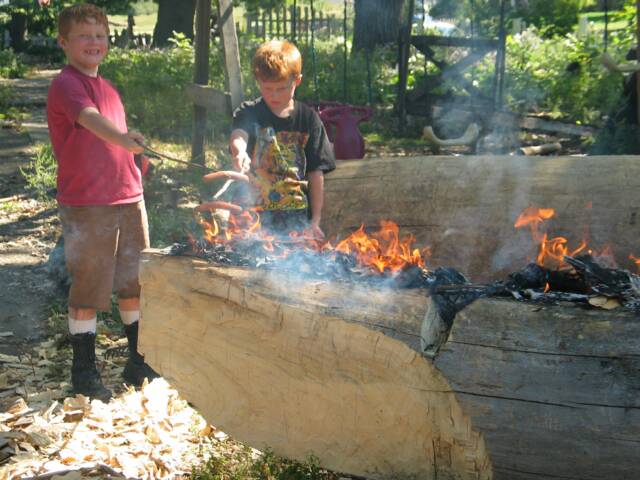
One of the points of doin' this, is to experience some of what it would have been like for earlier Americans. While I don't have to worry about the smoke from my dugout drawing the unwanted attention of enemy warriors, I did attract the attention of the Des Moines Fire Department. While they thought the dugout was an interesting project, the Des Moines Tribal Counsel had put a ban on outdoor burning of any kind. The Fire Warriors, though they thought the dugout was cool, still had to enforce the elder's outdoor burning ban. Back to sawin' and choppin' I guess. However, I did burn the dugout long enough to experience some of what it must have been like for the members of Lewis and Clark's Corps of Discover.
The first winter of the trek, 1804-05, the Corps wintered near a Mandan Village on the upper Missouri River. There were some bitter cold snaps that winter. Men were detailed to burn-out dugout canoes over the winter months. Diaries and journal entries indicate dugout detail was sooty and exhausting. However, it did keep the soldiers warm. I can attest to that. While it was probably close to 80 degrees while I was burnin', the line of fire along the dugout was more intense than a normal camp fire. Even though my fires were small, the heat radiated at me from an extended front, hitting me from both sides and head-on. It was hot. I was actually relieved when the fire department showed up and told me I'd have to put it out.
Gus-8 & Patriot-7, roast hotdogs on the dugout.
Here is a close-up of what the dugout looked like after it had been burned and scraped.
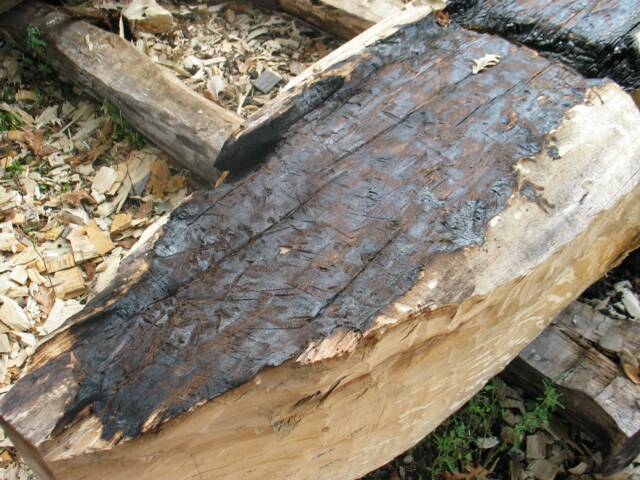
In three hours with my iron implements I've gotten three times as far than by burnin'.
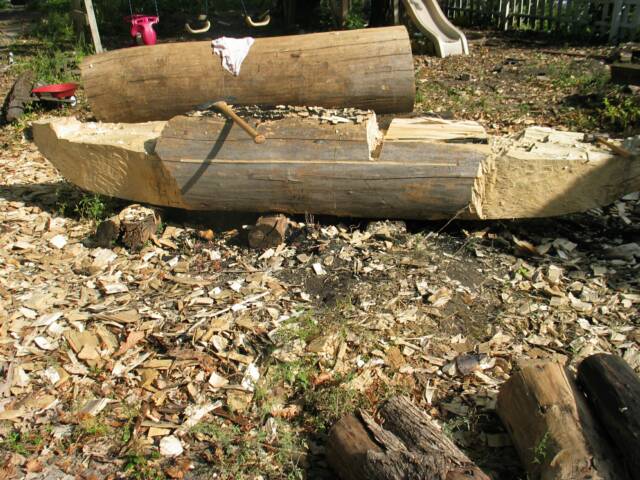
It didn't take long to get back in the swing of choppin' and splittin'. Wood's comin' off fast.
It's Tuesday, September 22nd, 2009; the first day of Autumn. I've got a blister, I'm tired, the boys are gettin' hungry, I've gott'a take a break.
After supper and the evening propaganda...I mean, ahem, news, I start choppin' and splittin' again. It starts to get dark but I keep on. I'm wonderin' to myself why I just don't stop for the day. My back aches and swingin' a blade when ya' can't see good isn't too smart. But, I'm close to gettin' the whole top split off. I want to see it that far before I quit. I wonder why I'm like that.
That train of thoughts leads me to thinkin' about the two men who probably had the most
to do with why I'm the way I am. The first is my Dad. He spent most of his life as a preacher. One of the most important things I learned from my father is: "Don't back down when you are right. Even if it would go better for you if you went along, stand up for what is right and do the right thing."
This wasn't just empty talk from my father. He pastored an all-white congregation in Kentucky and got involved in the Civil Rights movement. Folks in the church didn't have anything against colored folks, they just figured my dad needed to understand that everyone needed to know their place. My dad didn't see it that way. We had to leave Ol' Kaintuck.
At another church, I remember my dad helpin' a young soldier, just back from Vietnam, go through heroin withdrawals. Non-stop, my dad sat with him in the church basement. Sometimes dad had to pin the soldier's arms and legs and hold him down during the worst of the hallucinations. It was dangerous for the young vet to go through it that way, but my dad was in physical danger too. They both came out of it all right, but when the church found out, they weren't too happy with my dad. They didn't think a church basement was a place for a Vietnam vet to get the help he needed. We had to leave that church too. It was also my dad's service as a soldier that inspired my entrance into the Armed Forces. I learned a lot from my old man. I'm still standin' up for what's right, and I'm willin' to fight for it too.
Then there was Don Sower. I went to work for Don when I was about 21 or so. Don was the type of guy who figured he could do just about anything if he put his mind to it. Don did everything from shoe his own horses, to build houses, to invent machines. To Don's way of thinkin', if he just studied on a problem long enough, he could figure out a way to get that job whipped. Just by puttin' his mind to it, Don could figure out how to do a difficult job that would ordinarily take three men to do. But Don would figure out how to do it by himself with a piece of rope and three nails. For those rare jobs Don couldn't do by himself, he had me to hold up the other end. From Don I learned that there wasn't nuthin' a feller couldn't do if he just put his mind to it.
As light was failin', my thoughts wandered to current events. For some reason, I began thinkin' about how everyone from former President Jimmy Carter to the local newsman are all sayin' if you don't agree with Obama's programs you're a racist. Of course, this is just a diversion to explain why Washington's current policies are so unpopular, and has nothing to do with Obama at all. But it causes me to reflect on how far this nation has come since I was a young kid in my father's church.
Ever since I heard Martin Luther King's "I Have A Dream" speech when I was a kid, I wanted to be part of the generation who voted for the first black American President. I was a Allen Keyes supporter when he ran for president. That was about as close as I got. When I didn't like what either party was offering for president this last time around, I figured I had nuthin' to loose by checkin' out Obama. It only took me five minutes listenin' to him to realize he wasn't sayin' anything. But then, as I learned more about his socialist policies and Marxist background, I realized he was dangerouse for our nation.
I knew Obama would become President because everyone was caught up in the hype. And, like me, many individuals wanted to brag they had elected the first black President. On the one hand, I'm proud of America because a person's skin color has become so insignificant that a black man can be elected President. That alone proves America, as a whole, has overcome the racism. However, I'm saddened that so few people remembered Martin Luther King's words, nor took them to heart. When King said he had a dream, that someday, his children wouldn't be judged by the color of their skin, but by the content of their character, he was right-on. But, in the case of President Obama, this didn't hold true. President Obama was elected precisely because of the color of his skin. His character flaws and unsavory, anti-American policies were ignored.
Now, when America has begun to wake-up to the policies that came with the man, the nation is rejecting them. Since the news can't report the majority of Americans reject the socialization of America by the current residents of Washington, the media has to lie and make up a story about how racism has reared it's ugly head in America once again. That's flat out propaganda. There isn't a grain of truth to it. America is rejecting "Socialism", not skin pigmentation.
Now, I know this has nuthin' to do with dugout canoes. But, it's my website. I can say whatever I want to. And, like my father before me, I'm willin' to stand up for what's right no matter if the whole force and might of the Federal Government would be focused on my little life. If ordinary folks don't stand up for what's right, our children and grandchildren wont know what "right" was.
I've got thirty-three hours in this dugout as of today. One of the accounts I read said a man who knew what he was doin' could build a dugout in a week. Of course, in those days you didn't work a forty-hour week with time-and-a-half for overtime. You didn't get weekends off. You just did what had to be done. I still believe in that America.
With the hull roughed-out, I'm goin' to be needin' to be able to flip it over and start workin' on the contours of the bottom. But, the "Log that would be a dugout", still weighs about 500-600 pounds. I decide I'm goin' to have to gouge out the inside to cut the weight down.
I mark out where my seat and bulkheads are goin' to be. I chisel in the lines so I don't split 'em out with the axe. I mark a 1" line around the gunwales with my saddle compass to I know how thick the top edge of the hull will be.
Then, I set to choppin'. Shortly, I'm needin' another axe handle.
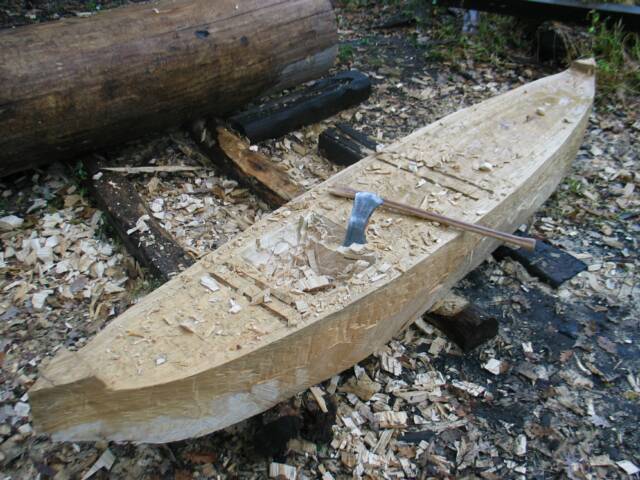
This new handle is standin' up better than the last three. I think I'll keep it. It doesn't take too long to hog out great chunks with this double blade. I don't want to get too thin on the sides and bottom with the mighty swings I'm layin' down. One slip and I could slice into wood I'm goin' to want to save to keep the water out.
The dugout still weighs a ton, but I'm whittlin' it down. I figure with each stroke of the blade I'm takin' off a few ounces. If you add up all the hundreds of pounds I still have to shave off this log to make it work, that's probably in the tens of thousands.
I've got a canoe/camping weekend coming up in October. I'd like to get the dugout done in time. I'm goin' to have to start puttin' in some seriouse whacks.
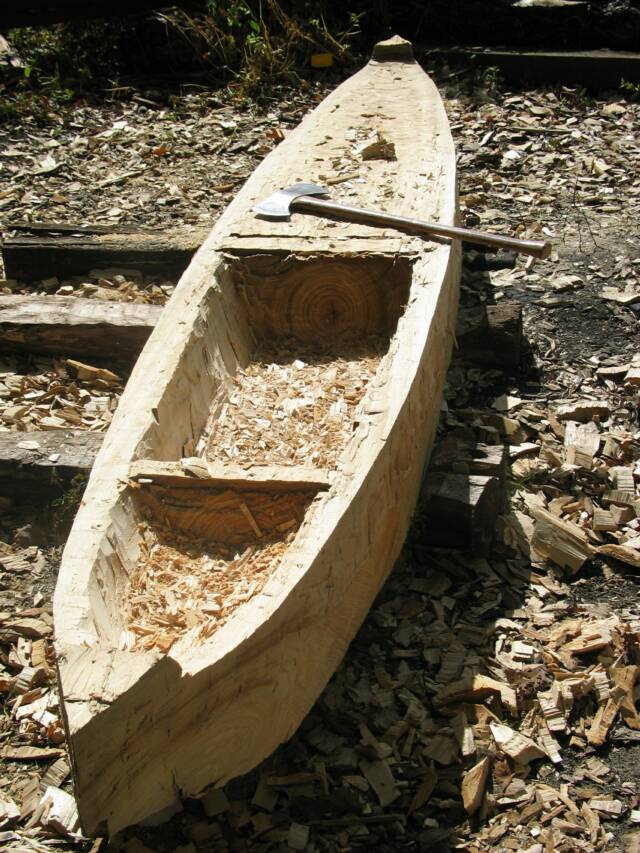
With a slab of wood left where the seat will be carved out, the dugout is light enough I can struggle it over without gettin' a hernia. So, I flip it over and start carvin' on the bow and stern to get a graceful lift up out of the water.
I'm spending longer hours on the dugout to try to get it finished. I shape the outside of the hull and char the surface. I'm doin' this for two reasons. The first is to temper the wood and make it tougher. The second is to make it easier to smooth off the surface. The boys and I selected a slab of sandstone from the river bank to use as a plane. Here you can see the wood that has been charred and what hasn't been burned yet. Scrappin' the sandstone back and forth across the bottom of the hull was the hardest and dirtiest work yet. It works pretty good for stone-age technology. I inhaled a lot of charcoal though.
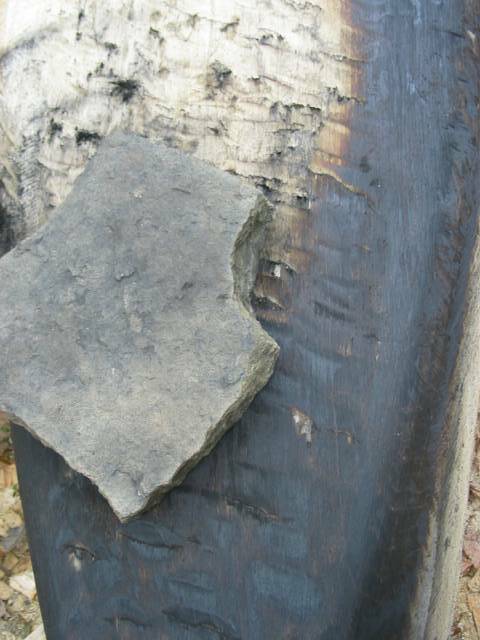
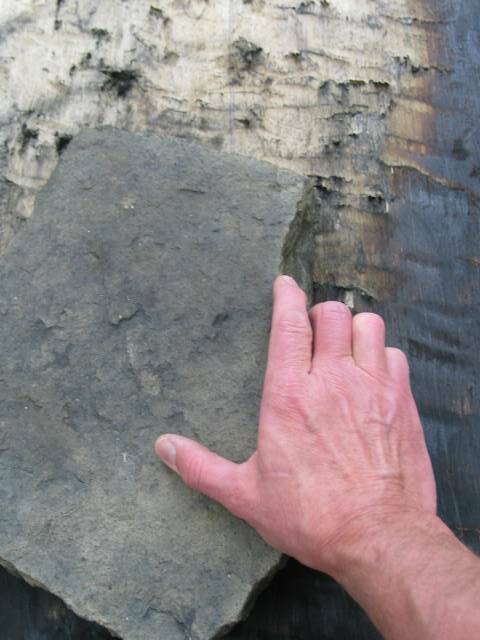
I finally have the hull the shape I want it, or at least close enough. I mix up a batch of boiled linseed oil and pine tar in a half-and-half mixture. Pine tar is the sticky liquid left in the bottom of the container when pine wood is cooked-down into charcoal for forges. It has been used to seal water craft since before the Vikings. Mixed with the linseed oil, it penetrates deep into the cottonwood.
I was goin' to make a caliper for measurin' the thickness of the hull out of period-correct materials. But, when it came right down to it, I was in too big of a hurry. So, I constructed one out of plywood. It worked just fine. here it is pictured on the bottom of the hull. The overnight rain is still beaded-up and not soakin' in to the cottonwood. I began thinning down the hull using the calipers to keep from cuttin' too deep, (though I did on several occassions!). The front half of the dugout is still roughed-out with the axe, while the back half has been whittled down to a hull thickness of 1" on the sides and 2" on the bottom.
This closer shot shows the difference in the 1" thickness of the back half of the hull, as compared to the front half that is still axe-hewn.
I have begun to carve out the seat, trying to make it as minimal as possible to cut down on the weight. My best guess is to bring the dugout in at about 150 pounds, drafting 2 1/2" inches of water. I've been thinkin' I could accomplish this with a hull thickness of 1" on the sides and 2" on the bottom. It is plenty sturdy at those thicknesses, but still weighs more than I think it should. But, the canoe weekend is comin' up in two days and I'm not goin' to have time to whittle it all down to my proposed finished thicknesses.
The museum original has a hull thickness of 5/8" on the sides and between 2 - 3 1/2" on the bottom. I think the dugout will be too heavy, even with the hull thicknesses I'm lookin' at. But, I've got one more day to work on it. Then, I'll have to stick it in the water and see if I can use it as is for the weekend.
It's the Friday before the canoe/campin' weekend. I haven't been able to whittle the front half down to the 1" and 2" hull thicknesses I wanted, but I've got to stick it in the water and see if I am goin' to be able to use it. It weights about 250 pounds, not the 150 I want. When I put it in the water it drafts 4" of water, not the 2 1/2" I'll need to paddle on the low autumn rivers. It sets a little too low in the water to challenge any kind of rough water. But I'm out of time. I've got 78 hours in it now. Not only will I have to leave it behind when I go canoe/campin', but I'll have to wait till spring to finish it. I need to scrape, patch, prime and paint the 110 year-old house before more snow flies.
In the spring, I'll take the hull down to 1/2" on the sides, and 1 1/2" on the bottom. That should get me down to about 175 pounds. With my scoutin' gear in the bow to counter-balance my weight in back, it should draft less than 3". At least, that's my hope. We'll have to wait till spring to see.
This is how much I got burned and scraped in three hours. It was enough that I can see it would take time.
SPRING 2010
Well, made it through the winter, snow was almost four feet at times. Third snowiest winter in recorded history. Antsy to get carvin' on the dugout. I need to be floatin' down a river soon!
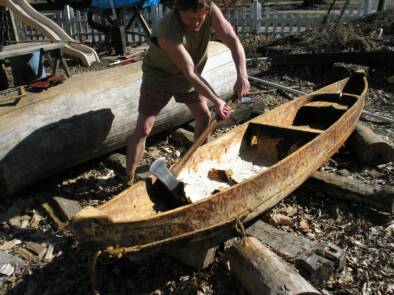
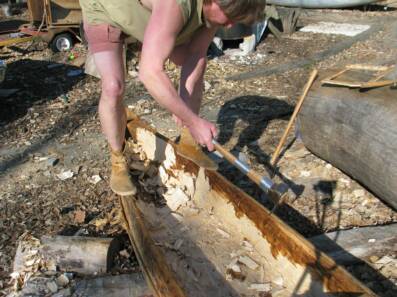
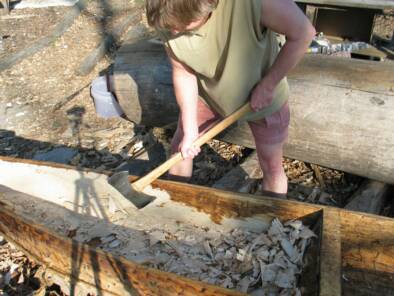
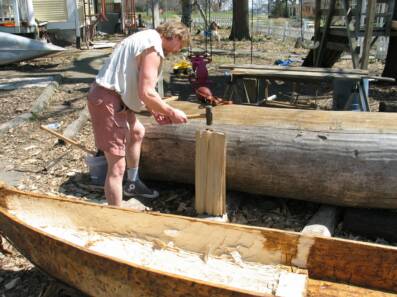
Too heavy. Got'ta whittle it down some. I'm cuttin' out the bulkheads and the carved seat.
Gettin' the sides and bottom thinned down too. Half inch sides, inch and a half bottom.
Rough trimmin' down the sides. Clean it up with the chisel.
Splittin' down a section of cottonwood to make the new plank seat replacement.
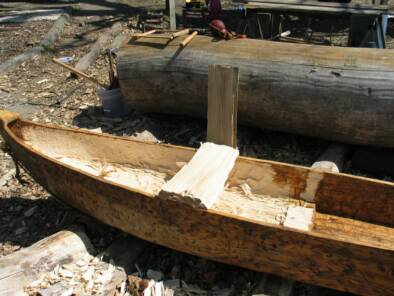
The new plank seat will ride further forward to better distribute my weight.
Chopped out the bulkheads and most of the carved seat. I found I had the grain goin' the wrong way, so I should switch ends of the dugout anyway. While I don't imagine paddlin' against the grain would make much difference with each stroke, I figure it would add up after a day paddlin' up river. Also, it will cause less scuffin' when I beach the craft.
